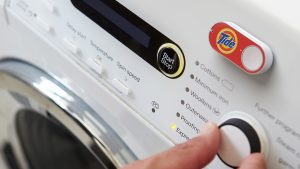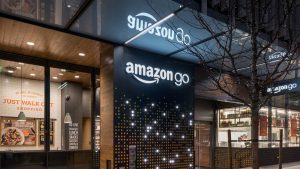“What’s dangerous is not to evolve”
Jeff Bezos, Amazon CEO.
Last week, alongside the launch of the new Sellerdeck site, we also started our new Podcast, The Insider’s Guide to E-commerce. We don’t mind admitting that the first episode of the podcast is very much a ‘beta test’ of the format, but hopefully you all get something out of it. For future episodes, we’ll be choosing varying topics and discussion points from the world of e-commerce and taking deep dives into them, hopefully to give you guys some useful information and answers to questions.
Episode one was largely focused around e-commerce giants, Amazon. If you’ve not yet listened to the podcast, we focus on 3 areas in which Amazon have branched out that may or may not revolutionise e-commerce as we know it. I wanted to follow up the podcast with this blog post to go further into those 3 areas and to look at how the average SME can compete in the Amazon Jungle.
The Amazon Dash button was introduced on March 31st 2015, possibly not the best launch date as many people (yours truly included) thought it to be an April Fool’s prank.
It wasn’t. In fact, Amazon had been developing the concept for a number of years and sales trebled over a two-month period. The dash button itself is about 2 inches long and an inch high. When pressed, it orders 1 particular item, each item has its own button. The premise is that you have a Dash Button in places where frequently re-ordered goods would be, for example:
- On your washing machine for ordering more fabric softener
- In the toilet for ordering more toilet roll
- By the sink for ordering more toothpaste
- In the storeroom for ordering more pet food.
Each Amazon Dash Button costs £4.99, although the cost of the button is taken off the first purchase. A press of the button places one order and orders can’t be placed more than once at a time. Product availability is ever growing, with over 150 products available to the US and around 40 in the UK. These products include things like cat food, kitchen roll, water, red bull, condoms, coffee, dishwasher tablets, batteries, paracetamol and many other things.
Whilst the dash button is certainly innovatory, with quick and efficient ordering, critics have been quick to criticise the massive amount of cardboard boxes being used.
Is the dash button the future of buying? Do people want buttons on every appliance in their house? Does it raise more problems than it solves or is it completely revolutionary? Time will tell.

Amazon Go – Checkout-less Supermarket
The next step on our list of Amazon evolution is “Amazon Go”, the first supermarket with no checkouts; walk in, pick up your shopping, walk out.
Free food!
Well, no. Amazon Go is all about machine learning and automation. As you walk in, you scan your phone; as you walk around, anything you pick up is added to your ‘virtual cart’, put something back and it’s removed. When you walk out, your Amazon account is automatically charged for everything you’ve taken. It works using (in Amazon’s words) computer vision, deep learning algorithms and sensor fusion; in layman’s terms, it’s really really clever stuff.
At the time of writing, the ‘beta’ store in Seattle is open to Amazon employees only but the concept is due to launch wider in 2017.
So whilst no one can argue that this is an incredibly clever idea, let’s look at some of the negatives at play here. Firstly, there’s a level of tracking that some people just might not be too happy with. Amazon will be tracking your phone, the items you buy and your habits. Your face will be scanned and of all your movements captured. There’s also the fact that if this catches on and becomes far wider spread, human jobs could be lost, but then who is to say that the concept won’t lead to more jobs in tech and data analysis?
But it’s something bigger than that, Amazon aren’t just experimenting with an idea, they’re looking to completely revolutionise shopping as we know it and to make a lot of money in the meantime. Amazon know how to make money by capturing a market; they revolutionised books and they lead the world of hosting (Amazon Web Service is Amazon’s most profitable arm) with sites like Netflix, Pinterest, AirBnB, Nasa, the WSJ and many many more all using their services.
The technology behind Amazon Go is patented, initially for their warehouse operations but with hints towards retail bases. That was step 1. Step 2 was to market the concept and this was done using a video on YouTube. At the time of writing, that video, which shows the checkout-less store working completely seamlessly, has over 8,000,000 views and no comments. Comments have been disabled and Amazon are not talking to the press. Why? Because they don’t need to. We’re sold on the idea. Of course it works! It’s genius, it’s trending and I want to try it!
Cut to 2 or 3 years down the line and Amazon have rolled out a few more shops and everyone loves this technology. What does the trillion dollar retail industry do? Turn to Amazon to install its tech in their stores and what does that mean for Amazon? Well, Jeff Bezos once made 6 billion dollars in 20 minutes. That might just become normal.

Just like Gerd Müller for West Germany vs Peru in 1970, our hat trick is completed by going airborne. Whilst I’m not sure how many people would be aware of Amazon Dash and Amazon Go just yet, Prime Air seems to be the relative talk of the town.
Debuted on December 7th 2016, Prime Air is Amazon’s drone delivery system. The first live delivery was made to “Richard B” in Cambridgeshire who received an Amazon Fire Stick and some popcorn. The time from order to delivery? 13 minutes. The other day my brother and I were chatting about the days when you’d place an order online and expect to wait 28 days for delivery.
13 minutes.
13… minutes.
Amazon’s plan is to have fleets of fully autonomous, unmanned drones getting packages to customers within 30 minutes of ordering. However, battery life, air space regulations and the fact that products need to be less than 2.6kg in weight and ordered by someone with a big garden living close to an Amazon warehouse may limit the end capabilities. However, with ‘X’ (Google’s sister company) also working on a similar project with the aim of delivering to rural areas, who knows what the future holds.
For now, standard ‘Prime’ deliveries of less than an hour (within certain postcodes) or next day delivery are still an incredible feat.

The average SME
So here you are, running a small online retailer reading all about Amazon’s endeavours. You’re never going to have a button for people to order your products, you’re (probably) never going to have a checkout-less retail store (not without paying Amazon for the privilege, anyway) and I doubt you’re ever going to be delivering your products using a fleet of flying robots, so how do you compete?
Well, you don’t.
More to the point, you don’t need to.
As smaller traders, we obsess about what the ‘big boys’ are up to and how we can keep up with them. Let’s take a step back and think about it though. Does your local corner shop selling magazines and milk etc worry about the out of town megastore? Probably not, because they have different target audiences. Will you always buy your milk at the corner shop? Probably not, but that’s fine.
The corner shop has a solution to a problem. It sells the day-in-day-out goods that people need, in close proximity to a certain number of houses.
Your SME e-commerce store also needs to fulfil a purpose. You need to have your niche and you need to evolve to serve your target audience’s needs. People are happy to pay the right price, or wait a bit longer for delivery if they know they’re getting a good product from a company they can trust to look after them throughout the process. To establish this, there’s a number of factors that come into play:
- Platform: Your website needs to be easy to use and pleasant on the eye.
- Brand: A brand that your customers can connect to and build trust with.
- Communication: Communication channels between you and your customers need to be open, making it easy for them to contact you.
- Service: Your delivery needs to be as prompt as possible and well carried out. Nice presentation goes a long way, even when it comes to something as simple as a delivery box.
- Feedback: A review system will help improve all of the above.
Whilst you don’t need to try and compete with the giants like Amazon, that doesn’t mean that you can rest on your laurels and take your foot off the proverbial gas. The e-commerce world is busier than ever and will only get busier and face more challenges. Without constantly evolving your own business to suit the needs of your customers and the changing landscape, you run the risk of being left behind.
While Amazon are running away with high-tech supermarkets and drone deliveries, you’re actual competitors are improving their sites, creating content, working on their SEO and looking to take your audience. With more waiting in the wings to join the party, don’t wait to evolve before it’s too late.
You don’t want to be a dinosaur.